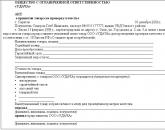Drafting and execution of reports and memos

"Personnel department of a budgetary institution", 2010, N 6
Drafting and execution of reports and memos
Memos and memos refer to the internal documents of the organization and are by no means uncommon, while they are often requested by regulatory authorities in the event of inspections. At the same time, personnel officers, as well as heads of departments, as a rule, have questions about the procedure for compiling and processing these documents. In this article, we will consider the existing norms on this issue, as well as generalize arbitration practice.
Legal regulation of official registration
And memos
There is currently no single regulatory legal act defining the term, as well as regulating the procedure for compiling and issuing official and memorandum notes. In the Concise Dictionary of Types and Varieties of Documents, developed by the Main Archive, VNIIDAD in 1974, the following definitions of these terms are proposed:
Memorandum - a document addressed to the management, stating any issue with the conclusions and proposals of the compiler;
Service note - a note on the performance of any work sent by one official to another.
The All-Russian classifier of management documentation OK 011-93, approved by the Decree of the State Standard of Russia dated 12/30/1993 N 299 (as amended on 06/08/2009, hereinafter - OKUD), contains a mention of a memorandum only in connection with a violation of labor discipline (unified form code N 0286041). It is usually compiled by the head of the unit in order to inform the head of the organization about a situation and encourage a decision to be made.
But memos are drawn up not only in case of violation of labor discipline. They can be used to notify the employer of the progress or results of work, the need for additional funding, labor or materials, etc. That is, memos provide a vertical link between levels of the job hierarchy and are submitted by lower officials to higher ones. Such notes can operate within the organization or be sent to higher authorities.
Regarding the memo, we can say the following: there is no mention of such a document in OKUD, however, in many regulatory legal acts regulating the activities of civil servants, it is mentioned on a par with the memorandum. Since there are no special requirements for its execution, we recommend that it be drawn up in the same way as a report, with the only difference being that an official of the same level of management will be indicated as the addressee (correspondence goes between departments). Most often, memos contain questions, requests, proposals for logistical, informational, organizational and economic support.
It is necessary to say about the terms of storage of documents of this type. According to paragraphs 408 and 413 of the List of typical management documents generated in the activities of organizations, indicating the storage periods, approved by the Federal Archive on 10/06/2000 (as amended on 10/27/2003), service and memos are stored for one year. After that, they can be destroyed in the manner prescribed by law.
Preparation of reports and memos
For the preparation of a memorandum or memo, there are rules set forth in GOST 6.30-2003 "Unified documentation systems. Unified system of organizational and administrative documentation. Requirements for the preparation of documents" (hereinafter - GOST R 6.30-2003). The first thing you should pay attention to is that documents are made on letterheads. The requirements for the forms of documents are established in sect. 4 GOST R 6.30-2003. In particular, it is indicated that the standard formats for blank documents are A4 (210 x 297 mm) and A5 (148 x 210 mm). For the manufacture of forms, white paper or light-colored paper is used. Each sheet of the document must have margins of at least 10 mm - right and at least 20 mm - left, top and bottom.
In addition, pay attention to the composition of the details and the rules for their placement on a sheet of paper. The list of details used in the preparation and execution of documents is listed in sec. 2 GOST R 6.30-2003. The most important and used of them in relation to the design of official and memorandums are:
Name of the structural unit;
Name of the document type;
Document date;
Registration number;
Title to the text;
Destination;
Compiler's signature (indicating position);
Visa document approval;
Resolution.
If an internal memorandum (memorandum) is drawn up, the name of the structural unit - the author of the document is indicated in the upper left corner. The name of the type of document must be written in capital letters (memorandum) and placed in the center or from the border of the left margin (depending on which method of arranging the heading of the document is angular or longitudinal) at two line intervals.
The date and index of the note are written on the same line. The date is written in Arabic numerals, for example: 02/02/2006, or in alphanumeric form, for example: February 2, 2006.
The registration number on the internal memorandum (service) note, depending on the procedure adopted in the organization, can be affixed at the place of compilation or at the place of receipt.
As a rule, memos and memos have a heading that briefly reveals the content of the document.
The text of reports and memos is stated in the first person singular ("I offer", "I ask"). In the resolution, information is indicated in the same order (for example, "I order").
In the text of the memorandum (official) note, two parts are distinguished. The first part reports the facts that gave rise to the drafting of the document, and the second sets out specific conclusions, requests and proposals. If in the text of the note it is necessary to present an analysis of the current situation, possible solutions, this is indicated after the first paragraph, and only in the third paragraph conclusions are drawn and proposals for specific actions are submitted. If the text contains several decisions, conclusions, etc., then it can be divided into sections, subsections, paragraphs, which are numbered in Arabic numerals.
In addition, information in the memorandum and memo can be presented in a tabular form. The columns and rows of the table must have headings expressed by a noun in the nominative case. The subheadings of columns and lines must be consistent with the headings. If the table is printed on more than one page, the columns of the table must be numbered and only the numbers of these columns are printed on the following pages. This is stated in clause 3.20 of GOST R 6.30-2003.
If there is an application, then a note about it is made before the signature is issued.
The requisite "Signature" includes: the name of the position of the person who signed the document (full, if the document is not issued on the form of the document, and abbreviated - on the document, issued on the form); personal signature; signature decoding (initials, surname). It is allowed in the "Signature" attribute to center the title of the position of the person who signed the document, relative to the longest line. When drawing up a document on the letterhead of an official, the position of this person is not indicated in the signature.
An external memorandum is drawn up on a common form and signed by the head of the organization. In this case, the full or abbreviated name of the parent organization is used in accordance with the charter of the organization. The name of the organization-author is placed below.
After consideration of the note by interested parties, approval visas are affixed to it, including the signature and position of the person approving the document, the decoding of the signature (initials, surname) and the date of signing. For a document whose original remains with the organization, visas are affixed at the bottom of the reverse side of the last page of the original document. For a document whose original is sent from an organization, visas are affixed at the bottom of the front side of the copy. It is possible to issue a visa document on a separate approval sheet. Sheet-by-sheet approval of the document and its application is allowed at the discretion of the organization.
If there are comments, they are set out on a separate sheet, which is signed and attached to the document.
After the decision is made, a resolution of the head is put on the document. The adoption of a resolution is the final stage in the consideration of the memorandum. The resolution, written on the document by the relevant official, includes the names, initials of the performers, the content of the order (if necessary), the due date, signature and date. It is allowed to issue a resolution on a separate sheet (clause 3.17 of GOST R 6.30-2003).
Let's give examples of memoranda and memos.
Accounting Department Chief Physician
Memorandum of MLPU N 18
No. 8 dated June 3, 2010 to E. O. Simonov
About allocation of funds
To participate in the seminar
06/23/2010 the training center "Profrazvitie" will hold a seminar on
The topic "New in accounting and taxation", revealing
Recent changes in legislation necessary for competent
Carrying out work by accounting staff.
I ask you to allocate funds in the amount of 5680 rubles. for visiting
this seminar.
Application:
1. Program of the seminar "New in accounting and taxation"
2. Payment order dated 06/02/2010 N 56.
Chief Accountant Kroshenina /A. V. Kroshenina /
Administrative and economic department Head of service
Service note of information support
From 27.05.2010 N 24
About the power outage
On Friday 05/28/2010 from 11.00 to 13.00 in the building of the enterprise will be
Electrical work is being carried out, in connection with this, it will be carried out
Power outage.
I ask you to take the measures necessary to prevent the loss of information
On electronic media.
Head of AHO Vetrov /P. A. Vetrov /
Features of registration of reports and memos
In public service institutions
In general, office work and execution of reports and memos in public service institutions comply with the rules established in GOST R 6.30-2003. At the same time, separate departmental legal acts may establish cases of their preparation and features of execution. In particular, the Order of the Federal Customs Service of Russia dated October 18, 2004 N 160 approved the Standard Instructions for Paperwork and Archive Operations in Customs Authorities. In sec. 3.8 shows three types of notes - reports, office, explanatory.
A memorandum is understood as a document addressed to the management of the customs authority, structural unit and informing about the current situation, the phenomenon or fact that took place, the work performed, containing the conclusions and proposals of the compiler. It is prepared both at the initiative of the compiler and at the direction of the management. The memorandum is drawn up on a standard sheet of A4 paper and has the following basic details: name of the structural unit, addressee, name of the type of document, date, number, title to the text, text, signature. The order of the details of the memorandum is specified in Appendix 8 to the Model Instructions.
Service notes are used to resolve operational issues arising in the management activities of the structural divisions of the customs authority (requests, clarification of tasks, information on requests, clarifications, etc.). These notes are compiled only on those issues that require mandatory documentary evidence. Correspondence between departments on issues that can be resolved promptly and do not require documentation is not allowed.
Registration of memos is carried out similarly to memos.
In some legal acts, there is only a mention of such a type of document as a service or official note, for example, in the Instructions for Record Keeping in Arbitration Courts of the Russian Federation (first, appeal and cassation instances), approved by Order of the Supreme Arbitration Court of the Russian Federation dated March 25, 2004 N 27. In these cases, if there are no intradepartmental instructions on this issue, it is necessary to be guided by generally binding norms, including GOST R 6.30- 2003.
K. V. Shestakova
Journal Expert
"Human Resources Department
budget institution"
Popular
- How to get a TIN: possible ways
- What kind of business can you do?
- Written notice of termination of the lease
- Business from scratch. Things to do?
- Cost of goods sold: formula, methodology and calculation example
- How to write a vacation application - examples
- What kind of business can be opened in a small town or village?
- The formula for calculating the cost of services, products sold and total cost
- Sample memorandum: I bring to your attention
- Example of an explanatory note for being late for work




